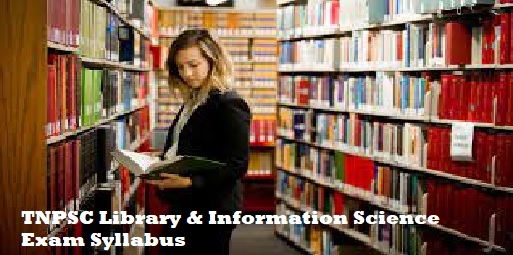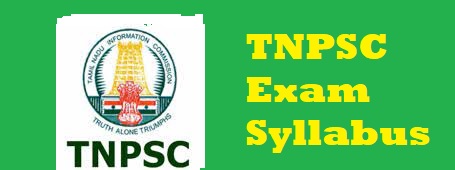TNPSC Library & Information Science Exam Syllabus
Organisation : Tamil Nadu Public Service Commission (TNPSC)
Exam Name : TNPSC Library & Information Science Examination
Standard : PG Degree Standard
Subject Code : 267
Announcement : TNPSC Library & Information Science Exam Syllabus
Website : https://www.tnpsc.gov.in/English/new_syllabus.html
TNPSC Library & Information Science Exam Syllabus
The TNPSC Library & Information Science Exam Syllabus are given below,
Related / Similar Syllabus :

UNIT – I Information And Communication:
(i) Data, Information and Knowledge; Information – Notions; Information Theories
(ii) Library – Social relevance; Types; Functions, Legislation.
(iii) Information Transfer Cycle; Diffusion pattern; Communication – Theories and Models; Channels and Barriers to Communication
(iv) Information / Memory institution of different kinds: Libraries, Archives, Documentation Centers, Information Analysis Centers, Museums and respective roles and functions.
(v) Professional bodies and Association – UNESCO, IFLA, ALA, CILIP, ILA, IASLIC, IATLIS, etc
UNIT–II Management Of Information Centres:
(i) Management – Concept, Definition; Schools of Management Thought, functions of Management (POSDCORB).
(ii) Human Resource Management – Organisation models; job description and job Analysis; selection, recruitment, training
(iii) Financial Management: Planning and Control; Resource generation; Budget and Budgeting; Budgetary control techniques; Cost Benefit, Cost Effective analysis
(iv) Materials Management: Collection development Policy; Issues – selection, acquisition; Library routines, Circulation, Preservation and conservation, Physical facilities – building and equipments, Marketing of information.
(v) Planning – Concept, Definition Types; Systems Analysis and Design; Knowledge Management, total quality management, MBO and MIS
UNIT-III Knowledge Organisation:
(i) Universe of Subjects; Modes of formation of Subjects; Knowledge Organization
(ii) Classification- Various Schemes of Classification – CC, UDC, LC and DDC – Overview; BSO; General theory of classification; CRG; Cannons and Principles – Idea, Verbal and Notation planes; Facet analysis;
(iii) Cataloguing – Purpose, Structure, Types – Inner and Physical forms; Normative Principles, Canons & Laws; Standards – ISBDs, AACR, RDA; FRBR
(iv) Subject Cataloguing – Principles; Subject heading lists; Thesauri and Vocabulary control
(v) Bibliographic formats – International Standards – ISO 2709, MARC21, UNIMARC, CCF and National formats. Metadata – Standards: Dublin Core, Mark up languages – HTML, XML, RDF
UNIT-IV Information Sources:
(i) Information Sources – Types – Documentary and Non documentary; Primary, Secondary and Tertiary; Electronic Sources of Information; Human and Institutional Sources; Invisible Colleges; TechnologicalGatekeepers
(ii) Reference Sources – Ready Reference Sources – Types – Dictionaries, Encyclopedias, Annuals, Biographical sources, Handbooks and Manuals, Geographical Sources.
(iii) Bibliographical Sources – Bibliographies; Union Catalogues; Indexing and Abstracting sources; News summaries;
(iv) Web Resources – Subject Gateways and Portals; Databases – Bibliographical, Abstracting and Indexing; Full-text databases; Citation Databases
(v) Evaluation of Information sources – Print and Web Resources; Multimedia; Open Access Resources
UNIT-V Information System, Products And Services:
(i) Information Systems – Concept, Purpose, and Types; Global & National Information Systems; MEDLARS, INIS, AGRIS, INSPEC, OCLC, ERONAT, NISCAIR, NASSDOC, Library Networks: INFLIBNET, DELNET, etc.
(ii) Information Services- Users Education and Information Literacy; Documents Delivery, Translation; Current Awareness, SDI, E-Alert & Web- based Services
(iii) Users of Information- Understanding the users; Categories of users and their needs; Information use contexts; Information seeking behaviour of users; Theories of Information seeking behaviour.
(iv) Information Analysis and Consolidation Products and Services.
(v) Use Studies; Methods of Users studies; Major information users and use studies and their findings
UNIT-VI Information Storage And Retrieval:
(i) Information Retrieval System – Concept, Definition, and Components
(ii) Indexing systems – Pre-coordinate and Post-coordinate; General Theory of Subject Indexing; Keyword Indexing; Citation Indexing
(iii) Information Retrieval Models – Boolean, Probabilistic, Cognitive and Vector Models; Alternative IR Models: algebraic and probabilistic models (Bayesian networks)
(iv) Search and Searching – Search Process; Search strategies; Search engines
(v) Evaluation of Information Retrieval Systems – Purpose, Criteria – Recall and Precision; Major Evaluation Studies – MEDLARS; SMART Retrieval; STAIRS, Project TREC.
UNIT-VII Research Methods:
(i) Research – Concept, Definition, Objectives and Significance; Types; Research Problems
(ii) Research Design – Definition, Need; Sampling; Hypothesis – Types and Testing
(iii) Methods and Tools – Data collection – Survey, Experimental, Case-study, Observation, Questionnaire, Interview schedules.
(iv) Introduction to Statistics; definition of statistical terms-population, sample, data and variables; frequency distributions; scales of measurement; presentation of data- graphical and tabular; frequency tables, histogram, frequency curves; correlation and regression analysis; measures of central tendency.
(v) Report Writing – Components of a Research Report; Style manuals – MLA, APA, Chicago, Turabian.
UNIT-VIII Information Technology (It) And Library Automation:
(i) Information Technology – Concept – Definition – Evolution of Digital Computers; Introduction to Telecommunications; Number Systems: Binary, Octal, Hexadecimal, Representation of Numbers in Computers; Character Representation: ASCII, ISCII and UNICODE; File formats
(ii) Basic components of a Computer – Arithmetic Logic Unit; Control Unit; Memory Unit – Static and Dynamic RAM, ROM, Cache memory; Input / Output devices
(iii) Operating System- Linux, Windows; Fundamentals of Programming; Introduction to C programming; Object Oriented programming; Java, PHP
(iv) Database Management System– Concepts, Functions; Integrity and Security issues
(v) Library Automation – Overview of library automation software; Criteria for selection of software; and Hardware (including differently-abled); Open and Commercial LMS

UNIT-IX Digital Libraries:
(i) Digital Libraries – Concept and Definition; Historical development of Digital
Libraries. Copyright and license issues.
(ii) Digitization Process – Software, Hardware and Best practices; Scanners and Scanner types; OCR and OCR software
(iii) Technology for DLs – Open source software – Open Standards and File formats; Harvesting metadata, OAI-PMH and DL Interoperability;
(iv) Digital Library Architecture – Grid architecture; Open URL integration;
(v) Digital Resources Management – Digital Preservation- Persistent identifiers – DOI and CNRI Handles; Multilingual digital repositories and Cross- language information retrieval
Download Syllabus
TNPSC Library & Information Science Exam Syllabus Link :
http://www.syllabus.gen.in/uploads/pdf2022/2877-syllabus.pdf